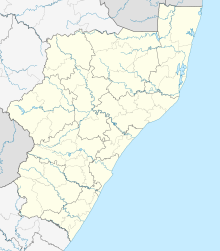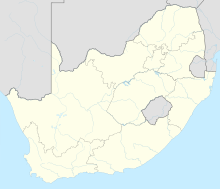
O. R. Tambo International Airport is an international airport serving the twin cities of Johannesburg and the main capital of South Africa, Pretoria. It is situated in Kempton Park, Gauteng. It serves as the primary airport for domestic and international travel for South Africa and since 2020, it is Africa's second busiest airport, with a capacity to handle up to 28 million passengers annually. The airport serves as the hub for South African Airways. The airport handled over 21 million passengers in 2017.

Cape Town International Airport is the primary international airport serving the city of Cape Town, and is the second-busiest airport in South Africa and fifth-busiest in Africa. Located approximately 20 kilometres (12 mi) from the city center, the airport was opened in 1954 to replace Cape Town's previous airport, Wingfield Aerodrome. Cape Town International Airport is the only airport in the Cape Town metropolitan area that offers scheduled passenger services. The airport has domestic and international terminals, linked by a common central terminal.

Durban International Airport was the international airport of Durban from 1951 until 2010, when it was replaced by King Shaka International Airport, 60 kilometres (37 mi) to the north. The airport is co-located with AFB Durban.

El Dorado International Airport is an international airport serving Bogotá, the capital of Colombia, and its surrounding areas. The airport is located mostly in the Fontibón district of Bogotá, although it partially extends into the Engativá district and through the municipality of Funza in the Western Savanna Province of the Cundinamarca Department. It served over 39 million passengers in 2023 making it the second busiest airport in South America and 3rd overall in Latin America in terms of passenger traffic, as well as being the 32nd busiest airport in the world in 2022. With 760,000 metric tons of cargo passing through the same year, it is also Iberoamerica's most important cargo hub. El Dorado is also by far the busiest and most important airport in Colombia, accounting for just under half (49%) of the country's air traffic. The facility covers 1,700 acres (6.9km2) and contains two 3,800m long runways. El Dorado has non-stop international flights to North America, South America, Central America, the Caribbean, Europe, and the Middle East.

Durban is the third-most populous city in South Africa, after Johannesburg and Cape Town, and the largest city in the province of KwaZulu-Natal. Situated on the east coast of South Africa, on the Natal Bay of the Indian Ocean, Durban is South Africa's busiest port and was formerly named Port Natal. North of the harbour and city centre lies the mouth of the Umgeni River; the flat city centre rises to the hills of the Berea on the west; and to the south, running along the coast, is the Bluff. Durban is the seat of the larger eThekwini Metropolitan Municipality, which spans an area of 2,556 km2 (987 sq mi) and had a population of 4.2 million in 2022, making the metropolitan population one of Africa's largest on the Indian Ocean. Within the city limits, Durban's population was 595,061 in 2011. The city has a humid subtropical climate, with hot, wet summers and mild, dry winters.

Sri Guru Ram Das Ji International Airport is an international airport serving Amritsar, Punjab, India. It is located at Raja Sansi, 11 km (7 mi) north-west from the city centre. It is named after Guru Ram Das, the fourth Sikh Guru and the founder of Amritsar. The airport is the largest and the busiest airport of Punjab. It is the third-largest airport in Northern India after Indira Gandhi International Airport in Delhi. The airport was the 3rd fastest-growing airport in India during the fiscal year 2017–18. It is a hub of cargo movements, domestically and internationally. The airport is ranked the 6th-best regional airport in India and Central Asia in 2019 and 2020 by Skytrax. The airport is awarded as the best airport in Asia-Pacific in 2020 by Airports Council International. The airport also featured in the top 10 airports in India and South Asia with Best Airport Staff for the year 2024 by Skytrax.
Hibberdene is a small coastal town on the KwaZulu-Natal South Coast in South Africa, approximately 23 km north-east of Port Shepstone and 90 km south-west of Durban and halfway between coastal towns of Scottburgh and Margate.
Isipingo is a town situated 19 kilometres (12 mi) south of Durban in KwaZulu-Natal, South Africa and currently forms part of eThekwini Metropolitan Municipality. The town is named after the Siphingo River, which in turn is thought to be named for the intertwining cat-thorn shrubs (Scutia myrtina) present in the area, or the river's winding course.
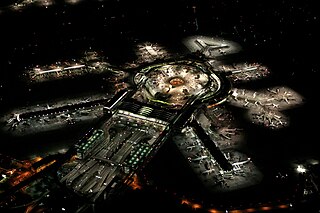
An international airport is an airport with customs and border control facilities enabling passengers to travel between countries around the world. International airports are usually larger than domestic airports, and feature longer runways and have facilities to accommodate heavier aircraft such as the Boeing 747 and the Airbus A380 commonly used for international and intercontinental travel. International airports often host domestic flights, which helps feed both passengers and cargo into international ones.
Comair Limited was an airline based in South Africa that operated scheduled services on domestic routes as a British Airways franchisee. It also operated as a low-cost carrier under its own kulula.com brand. Its main base was OR Tambo International Airport, Johannesburg, while focus cities were Cape Town, flying from Cape Town International Airport and Durban, King Shaka International Airport. Its headquarters were near OR Tambo in the Bonaero Park area of Kempton Park, Ekurhuleni, Gauteng.
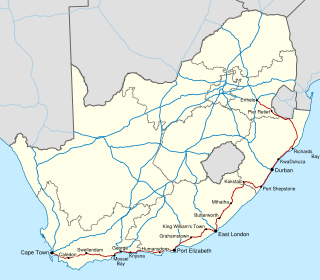
The N2 is a national route in South Africa that runs from Cape Town through George, Gqeberha, East London, Mthatha, Port Shepstone and Durban to Ermelo. It is the main highway along the Indian Ocean coast of the country. Its current length of 2,255 kilometres (1,401 mi) makes it the longest numbered route in South Africa.
Interlink Airlines Pty Ltd. was an airline based in Johannesburg, South Africa, operating scheduled and chartered flights out of OR Tambo International Airport. Its IATA code has since been reassigned to Batik Air.

New Chitose Airport is an international airport located 2.7 nautical miles south-southeast of Chitose and Tomakomai, Hokkaidō, Japan, serving the Sapporo metropolitan area. By both traffic and land area, it is the largest airport in Hokkaidō.

Velvet Sky was a low cost airline based at the King Shaka International Airport near Durban, South Africa. The airline launched in March 2011. It ceased operations in February 2012 and was liquidated in May 2012.
Singapore Changi Airport, or simply Changi Airport, is the primary civilian airport in the Republic of Singapore, and one of the largest transportation hubs in Southeast Asia. It is located approximately 17.2 km (10.7 mi) northeast from the commercial centre in Changi, on a 13 square kilometres (5.0 sq mi) site.
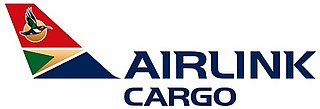
Airlink Cargo is a division of SA Airlink (Pty) Ltd and provides air freight transport services to over 35 destinations across Southern Africa from its base at O. R. Tambo International Airport. The division was formed in 2011 after one British Aerospace Jetstream 41 passenger aircraft belonging to parent company Airlink was converted for freight operations, followed the next year by a second aircraft. Freight is also carried on Airlink Cargo's behalf by Airlink and Swaziland Airlink across the region. Airlink Cargo is headquartered on the grounds of their hub near Johannesburg, South Africa.
Dube Tradeport Corporation is a business entity of the KwaZulu-Natal Provincial government in South Africa that manages a 3,000ha infrastructure project called the Dube Tradeport Special Economic Zone set up to promote local and international trade. Located at the King Shaka International Airport, it is situated 30 minutes from Durban Harbour, 90 minutes from the Richards Bay Harbour, and has an international airport, a cargo terminal, warehousing, offices and an agricultural zone.
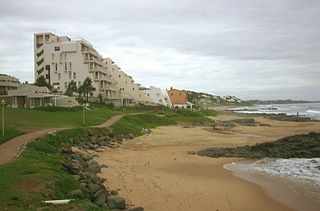
The KwaZulu-Natal North Coast, better known as the North Coast is a coastal region north of Durban in KwaZulu-Natal, South Africa. It stretches from Zinkwazi Beach in the north to Zimbali near Ballito in the south. The coastal region is governed by the KwaDukuza Local Municipality, forming part of the iLembe District Municipality.
The M65 also named Dube Boulevard is a short metropolitan route in the eThekwini Metropolitan Municipality, South Africa linking the N2 and R102 to King Shaka International Airport and Dube TradePort in La Mercy, north of Durban.


